A day trip for the whimsical and adventurous
This trip goes through a couple of little provinces south of Bangkok, but it's close enough and can be done in a day from Bangkok, so I'm putting it up here.
The station is tiny, train waiting right alongside the road, surrounded by market and boasting (in the mornings, at least) a fine selection of hot breakfast options along the platform. After buying our tickets for Mahachai (10 baht a head) and investigating the various food stalls, we sat at a khanom jeen seller's table and were able to hop from there straight onto the train when a departure announcement blared over our heads. (Note to anyone planning to do this trip - pick up a train schedule at Wongwien Yai, which has times for the Mahachai and Mae Klong trains - useful for thinking ahead and avoiding long waiting periods in middle-of-nowhere places).
The Mahachai train passes bursting greenery, tiny lopsided rows of houses, more markets, highway junctions, temples, little stations (some of these attached to temples), old wooden homes surrounded by water and little bridges. Our ride was pleasant, after the rain, watching the cooled-down land run past.
Reaching Mahach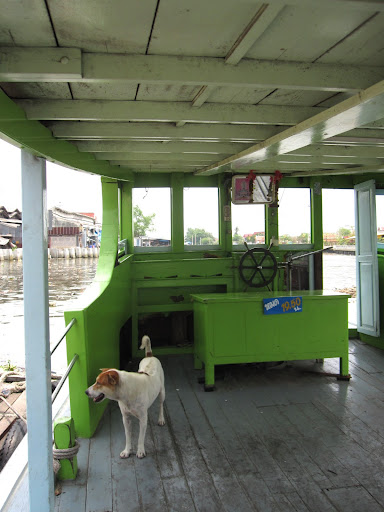 ai (which I can vouch for as a wonderful place for a seafood lunch, from previous visits), we made our way through its sprawling market - selling all sorts of sea-creatures, fresh-water beasts and amphibians, dried and gulping-fresh and all states in between - to the harbour, where ferries were coming and going. According to our photocopied Lonely Planet page, we wanted the ferry to Bang Laem, so we asked around and boarded it - then waited an hour for it to depart, watching the other ferry make several trips back and forth across the harbour. When our ferry did eventually cross the water (with an increasingly agitated dog that had wandered onto it), it took us to a pier that led straight up to Bang Laem station, where another 10 baht got us a ticket for the next leg of our journey, to Mae Klong - though the train wasn't to leave for another hour.
ai (which I can vouch for as a wonderful place for a seafood lunch, from previous visits), we made our way through its sprawling market - selling all sorts of sea-creatures, fresh-water beasts and amphibians, dried and gulping-fresh and all states in between - to the harbour, where ferries were coming and going. According to our photocopied Lonely Planet page, we wanted the ferry to Bang Laem, so we asked around and boarded it - then waited an hour for it to depart, watching the other ferry make several trips back and forth across the harbour. When our ferry did eventually cross the water (with an increasingly agitated dog that had wandered onto it), it took us to a pier that led straight up to Bang Laem station, where another 10 baht got us a ticket for the next leg of our journey, to Mae Klong - though the train wasn't to leave for another hour.
An aside on that note - I'd advise anyone making this trip to check the time of the ferry, and if it's a long wait to either have a nice lunch in Mahachai, or get the more regular ferry and seek out a motorbike taxi to Bang Laem.
There are, however, several temples near Bang Laem station, so Alex and I took a meander around the station to see them. One was setting up for a fair, another had a Chinese cemetery attached. Then back to the station and onto the train, snacking on i-teem boran, passing through fields and salt flats, lulled by the motion and humidity into snoozing. As we trundled towards the end of the line we passed market-awnings pulled out of the train's way, still bare centimetres from the windows, held tightly back by shopkeepers. Disembarking, we hurried back the way the train had come, hoping to see the market setting itself back up... and found those same awnings on long poles, extending over our heads, making a shady corridor of the tracks. Produce was piled up on the ground, right up to the rails. It almost looked like an ordinary, undisturbed market alley, apart from a few tell-tale signs - the rails under our feet, well-stocked tables cosily close but resting on rollers, easy to pull back.
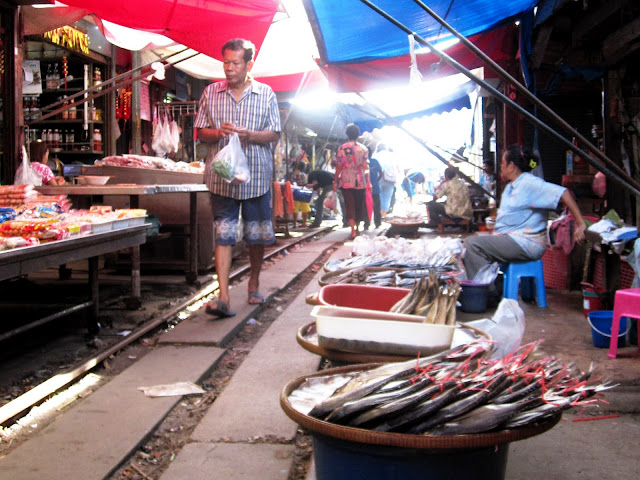

We went for a stroll about Mae Klong town, returning to the market in time (we thought) to see the train departing again. The market was as we left it, so we assumed the train had not yet been through - until we saw the station, empty. It was hard to believe the market had cleared - awnings, tables, vendors, shoppers and all - and restored itself in the time we'd been away; maybe the train had vanished into the air instead, or been eaten by the market. I was sad to have missed the sight of it setting back up behind the train, but have since found some youtube videos: this one of the train going by, filmed from the market, this one from the back of the train as it goes through.
More market pictures (my camera gave out after this, sadly, so no pictures from the end of the journey):
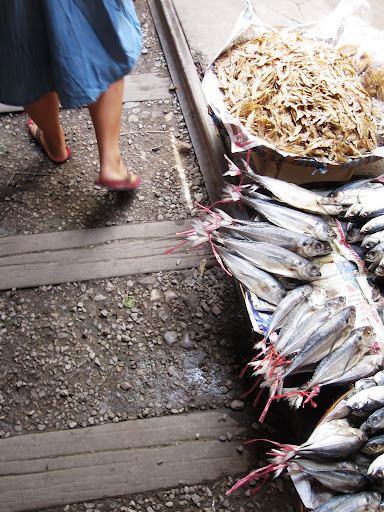
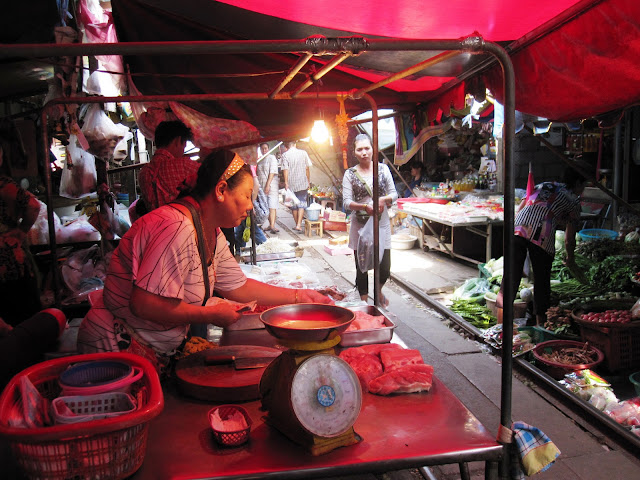
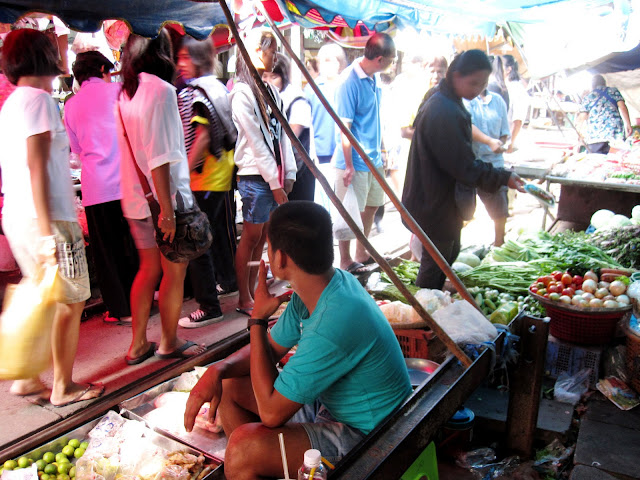
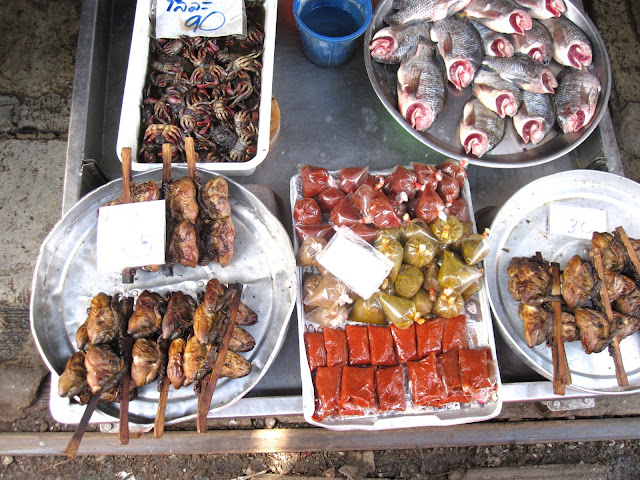
Near the market several large blue songtaew were parked, and we, asking how to get to our next destination, Ampawa, were directed to the number 1. This took us over canal-crossed land (and super-steep bridges) to the town of Ampawa, whose floating market makes a refreshing change from the tourist traps that Bangkok's floating markets have become. Ampawa is a tourist destination too, but one frequented by Thai rather than farang visitors, and it shows. The covered market sells kitsch countryside souvenirs like wind-up toys and old-fashioned sweets, and the floating market itself consists of boats that each cook and serve one or two dishes - we sampled the pad thai, prawn fritters, grilled scallops and Thai iced tea, perched on stools at the top of a steep flight of canal-side steps.
Ampawa's main temple also reportedly has some very fine murals (a particular cultural fetish of mine) which I didn't get the time to check out. It also looks like a charming place to stay for a night, with tiny guesthouses, little bars overlooking the canals, and the promise of fireflies at night - I guess I'll just have to go back...
But we needed to get back to Bangkok. There was a bus parked in the temple grounds, and knowing there are regular buses between Ampawa and Bangkok, I asked the driver if he was heading city-wards. He said yes, but this particular bus had been hired by a tour group - but after a quick chat they offered us a ride. There weren't enough seats for everyone - Alex was given a plastic chair in the aisle - and the group gave us both bottled water. We drove under the sunset through the salt flats, stopping at a market by the highway so members of the tour group could buy fruits and freshly-dried sea salt. On the road again, the tour leader raffled off Buddhist amulets, seat numbers picked from a hat by various tour members. It was a lovely, unexpected ending to the day. They dropped us at Central Rama II from where we took a bus to Silom, and a tuk-tuk back to mine. Silom was lined with police trucks and razor wire - something I'd almost managed to forget about during the day.
Resident or visitor, if you haven't taken the train to Mae Klong yet, go. It's cheap (the whole day cost me under 300 baht, including transport, two meals, snacks, and souveniers) and easy to do from the city but feels like a different world.
The Mahachai train passes bursting greenery, tiny lopsided rows of houses, more markets, highway junctions, temples, little stations (some of these attached to temples), old wooden homes surrounded by water and little bridges. Our ride was pleasant, after the rain, watching the cooled-down land run past.
Reaching Mahach
An aside on that note - I'd advise anyone making this trip to check the time of the ferry, and if it's a long wait to either have a nice lunch in Mahachai, or get the more regular ferry and seek out a motorbike taxi to Bang Laem.
There are, however, several temples near Bang Laem station, so Alex and I took a meander around the station to see them. One was setting up for a fair, another had a Chinese cemetery attached. Then back to the station and onto the train, snacking on i-teem boran, passing through fields and salt flats, lulled by the motion and humidity into snoozing. As we trundled towards the end of the line we passed market-awnings pulled out of the train's way, still bare centimetres from the windows, held tightly back by shopkeepers. Disembarking, we hurried back the way the train had come, hoping to see the market setting itself back up... and found those same awnings on long poles, extending over our heads, making a shady corridor of the tracks. Produce was piled up on the ground, right up to the rails. It almost looked like an ordinary, undisturbed market alley, apart from a few tell-tale signs - the rails under our feet, well-stocked tables cosily close but resting on rollers, easy to pull back.
We went for a stroll about Mae Klong town, returning to the market in time (we thought) to see the train departing again. The market was as we left it, so we assumed the train had not yet been through - until we saw the station, empty. It was hard to believe the market had cleared - awnings, tables, vendors, shoppers and all - and restored itself in the time we'd been away; maybe the train had vanished into the air instead, or been eaten by the market. I was sad to have missed the sight of it setting back up behind the train, but have since found some youtube videos: this one of the train going by, filmed from the market, this one from the back of the train as it goes through.
More market pictures (my camera gave out after this, sadly, so no pictures from the end of the journey):
Near the market several large blue songtaew were parked, and we, asking how to get to our next destination, Ampawa, were directed to the number 1. This took us over canal-crossed land (and super-steep bridges) to the town of Ampawa, whose floating market makes a refreshing change from the tourist traps that Bangkok's floating markets have become. Ampawa is a tourist destination too, but one frequented by Thai rather than farang visitors, and it shows. The covered market sells kitsch countryside souvenirs like wind-up toys and old-fashioned sweets, and the floating market itself consists of boats that each cook and serve one or two dishes - we sampled the pad thai, prawn fritters, grilled scallops and Thai iced tea, perched on stools at the top of a steep flight of canal-side steps.
Ampawa's main temple also reportedly has some very fine murals (a particular cultural fetish of mine) which I didn't get the time to check out. It also looks like a charming place to stay for a night, with tiny guesthouses, little bars overlooking the canals, and the promise of fireflies at night - I guess I'll just have to go back...
But we needed to get back to Bangkok. There was a bus parked in the temple grounds, and knowing there are regular buses between Ampawa and Bangkok, I asked the driver if he was heading city-wards. He said yes, but this particular bus had been hired by a tour group - but after a quick chat they offered us a ride. There weren't enough seats for everyone - Alex was given a plastic chair in the aisle - and the group gave us both bottled water. We drove under the sunset through the salt flats, stopping at a market by the highway so members of the tour group could buy fruits and freshly-dried sea salt. On the road again, the tour leader raffled off Buddhist amulets, seat numbers picked from a hat by various tour members. It was a lovely, unexpected ending to the day. They dropped us at Central Rama II from where we took a bus to Silom, and a tuk-tuk back to mine. Silom was lined with police trucks and razor wire - something I'd almost managed to forget about during the day.
Resident or visitor, if you haven't taken the train to Mae Klong yet, go. It's cheap (the whole day cost me under 300 baht, including transport, two meals, snacks, and souveniers) and easy to do from the city but feels like a different world.
This is a wonderful, vivid post, and I now really want to write a story about a market on train tracks.
ReplyDeleteSo do I, and I think Alex might too... let's all do it! Fiction editors clearly do not have enough train-track-markets in their lives - they will thank us for the awesome.
ReplyDeleteProfessionally written blogs are rare to find, however I appreciate all the points mentioned here. I also want to include some other writing skills which everyone must aware of.
ReplyDeleteลากรถ